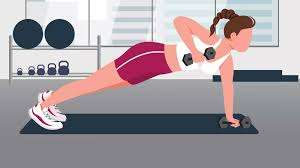High-Intensity Interval Training, or HIIT, has become a buzzword in the fitness industry.
From fitness influencers to research-backed articles, it is often hailed as the ultimate workout for getting Lean and Fit.
But is HIIT truly the secret weapon for transforming your body, or is it just another trend that is been overhyped?
Having tried HIIT myself, I have encountered both the promise and the pitfalls of this intense workout style.
In this article, I shall dive deep into the science behind HIIT, weigh the pros and cons, and explore whether it lives up to the lofty expectations.
Points Covered in the Article:
- What is HIIT?
- How HIIT Works for Fat Loss and Fitness
- The Pros of HIIT: What the Science Says
- The Disadvantages of High-Intensity Interval Training
- High-Intensity Interval Training Pros and Cons: My Personal Experience
- The Science Behind HIIT: What Studies Reveal
- Daily Lifestyle Challenges: Can HIIT Really Fit In?
- FAQs on HIIT and Losing Visceral Body Fat
- Conclusion: Is HIIT the Secret to Getting Lean and Fit, or Just Overhyped?
What is HIIT?
How HIIT Works for Fat Loss and Fitness?
HIIT, or High-Intensity Interval Training, is not just a trendy acronym—it is a metabolism-boosting, time-saving, fat-frying miracle wrapped in short, sweaty bursts of movement. The beauty of HIIT lies in its efficiency.
You push yourself to the max for 20 to 60 seconds, catch your breath during a brief recovery, and repeat. It sounds simple, but it is a full-on metabolic firestorm.
Here is why: those short bursts skyrocket your heart rate, spiking your oxygen demand. Even when you stop moving, your body stays revved up—burning calories like a furnace.
This phenomenon is called Excess Post-Exercise Oxygen Consumption (EPOC), also known as the “afterburn effect.” Think of it as your body continuing to pay off an oxygen debt, which requires extra energy—and that means more calories torched, even while you’re lying on the couch post-workout.
According to research published in the Journal of Sports Sciences, HIIT can burn up to 25–30% more calories than steady-state cardio in the same time frame.
And it is not just for fat loss—HIIT also improves VO₂ max (a key indicator of cardiovascular health), insulin sensitivity, and even boosts mood through endorphin release.
Take this example: a 20-minute HIIT session with 30 seconds of sprinting and 90 seconds of walking, repeated 10 times, can burn as many calories as a 45-minute jog. For someone managing a jam-packed schedule, that is a win-win.
And you do not need fancy equipment. Bodyweight moves like planks, burpees, mountain climbers, or push-ups work just fine. You can torch fat in your living room—no gym required.
So whether you are chasing fitness goals or just chasing toddlers, HIIT offers a fast lane to fat loss and cardio conditioning, with a side of sweat and satisfaction. 
The Pros of HIIT: What the Science Says
There is a reason HIIT has gained such widespread attention—it works for many people.
The hiit training pros and cons are widely discussed, but let’s start with the pros.
A study published in Sports Medicine found that HIIT can improve both aerobic and anaerobic fitness, increase muscle mass, and promote fat loss, especially in those who are already overweight or obese.
The quick nature of the workout that improves cardiovascular endurance is another major advantage.
For someone with a tight schedule, being able to get a full-body workout in a fraction of the time compared to traditional workouts is a game-changer. Another benefit?
HIIT workouts can be adapted to various fitness levels, from beginners to athletes, making it accessible to a broad audience.
HIIT workout facts also show that this form of training can improve insulin sensitivity, which is critical for managing blood sugar levels, especially for those at risk of diabetes.
According to a study in the Journal of Diabetes Research, just two weeks of HIIT improved insulin sensitivity by as much as 28%.
>>> Click Here to Learn How I Clubbed “Smoothies with HIIT” to Lose “Visceral Body Fat” in 4 Weeks <<<
The Disadvantages of High-Intensity Interval Training
While HIIT can be effective, it is not without its downsides.
One of the disadvantages of high-intensity interval training is the risk of injury.
Because you are pushing your body to its limits, improper form or lack of adequate rest between sessions can lead to strains, sprains, or even more severe injuries.
Another issue is that HIIT can be too intense for some people, especially beginners.
The disadvantages of interval training also include the fact that many people simply cannot sustain the high-intensity level required for extended periods, which can lead to burnout or frustration.
In my own experience, there were days when my body just could not keep up.
As much as HIIT is marketed as a time-saver, the reality is that the workouts are brutal.
Some days, I felt too exhausted to maintain the intensity required, which undermined my progress.
High-Intensity Interval Training Pros and Cons: My Personal Experience
When I first started HIIT, I was drawn to the idea that I could get lean and fit with minimal time investment.
Initially, the results were promising—I felt more energetic, and my endurance improved significantly.
The fat loss also started to show after a few weeks of consistent effort.
However, I quickly discovered the pros and cons of HIIT workouts.
While the workout was undeniably effective, it was also mentally and physically exhausting.
There were days when I would dread doing a session because I knew how hard it would be.
For me, the biggest con was the difficulty in maintaining consistency.
Life gets busy, and when you are fatigued, doing a HIIT workout is the last thing you want to tackle.
The Science Behind HIIT: What Studies Reveal
While my personal experience has been a mix of highs and lows, the science behind HIIT is compelling.
A study from the British Journal of Sports Medicine found that HIIT could burn 25–30% more calories than other forms of exercise, such as steady-state cardio.
The research also suggests that HIIT can lead to greater fat loss, particularly around the abdomen, which is often a stubborn area for many people.
One of the key hiit workout facts is the concept of EPOC, which I mentioned earlier. EPOC helps you burn additional calories after the workout is over, which is a huge advantage if your goal is to lose fat.
However, it is essential to remember that you only get out what you put in. HIIT requires maximum effort, and if you are not pushing yourself, you won’t see the benefits.
But with all these promising studies, there are also researchers who caution against overhyping HIIT.
According to the Journal of Physiology, while HIIT can improve cardiovascular fitness, it is not a magic bullet for everyone.
Factors like age, fitness level, and consistency play a huge role in how effective HIIT will be for each individual.

Daily Lifestyle Challenges: Can HIIT Really Fit In?
HIIT is often marketed as the perfect workout for busy people especially TABATA HIIT exercise sessions, but in practice, it is not always easy to incorporate into daily life.
Despite the short duration of a HIIT session, the intensity is demanding, both mentally and physically.
From my experience, after a grueling HIIT workout, I needed ample recovery time, which often conflicted with my busy schedule.
Unlike a light jog, hiking trails or a yoga session, you cannot just slot in HIIT anywhere in your day.
Moreover, one of the high intensity interval training pros and cons is that while HIIT is effective, it cannot be your only form of exercise.
To truly get lean and fit, most people will need to supplement HIIT with other forms of training, such as deadlifts or steady-state cardio.
So, even though HIIT can offer great benefits, it may not always fit perfectly into a balanced fitness routine.
FAQs on HIIT and Losing Visceral Body Fat
Q-1: If HIIT is so short, how can it compete with longer workouts for fat loss?
A-1: HIIT creates a high “calorie flux” in little time by spiking heart rate, recruiting big muscle groups, and nudging post-exercise oxygen use. But the magic isn’t the afterburn—it is adherence and muscle-sparing. Two 15–20 minute HIIT sessions plus steps and basic lifting can match the weekly energy deficit of longer routines if you keep eating steady and don’t “reward” every hard session with extra calories.
Q-2: Why do some people stall on HIIT even when they push hard?
A-2: Compensation. Intense sessions can boost appetite and shrink non-exercise movement (you sit more afterward). Without a step target or protein-forward meals, your weekly deficit evaporates. Fixes: set a step floor (e.g., 7–10k), schedule a protein + produce meal within 60–90 minutes of HIIT, and keep sugary “treats” out of the post-workout window.
Q-3: Is HIIT better for fitness than steady cardio, or do they build different engines?
A-3: Different engines. HIIT raises peak aerobic power and tolerance for high efforts; steady “zone 2” work builds mitochondrial density and recovery capacity. The leanest, fittest programs usually blend both: 1–2 HIIT days to push the ceiling, 1–2 zone-2 days to raise the floor, plus 2–3 short strength sessions to protect muscle and joints.
Q-4: What’s the safest entry point so HIIT doesn’t become “High-Impact Injury Training”?
A-4: Choose low-impact modes first: bike sprints, rowing, incline treadmill, or shadow boxing. Start with 6–8 rounds of 20–30 seconds hard / 90–120 seconds easy, total 12–18 minutes after warm-up. Keep effort at 8–9/10 (not 11/10), and leave one “good rep” in the tank. If joints grumble or sleep worsens, hold volume steady and improve recovery before adding reps.
Q-5: How do I know HIIT is actually helping me get lean and fit—not just tired?
A-5: Track effects, not just effort. Weekly: resting heart rate, perceived energy, and a tape-measure check at the waist. Every 2–3 weeks: repeat a benchmark (e.g., 6×30-second bike sprints—can you hold higher average power at the same perceived effort?). If waist and performance improve while body weight trends down or stable, HIIT is working. If performance stagnates and cravings spike, reduce HIIT to 1–2 days, add a zone-2 day, and tighten the post-workout meal.
Conclusive Analysis:
So, is HIIT the secret to getting lean and fit, or is it just overhyped?
In reality, it falls somewhere in between.
While HIIT can be an incredibly effective tool for fat loss and improving fitness, it is not a one-size-fits-all solution.
The pros and cons of HIIT workouts are clear: it is efficient, burns fat quickly, and improves cardiovascular health, but it can also be mentally and physically draining and carries a higher risk of injury.
The facts about HIIT training are promising, but it is essential to recognize that it is not a magic bullet. It works best when combined with other types of training and should be tailored to your personal fitness level and goals.
In my own experience, HIIT helped me lose fat and build endurance, but the intensity was hard to sustain over the long term.
While I would not dismiss HIIT altogether, I have learned that for most people, it should be part of a larger, more balanced fitness regimen.
Whether or not HIIT will work for you depends on your consistency, effort, and ability to recover.
References: